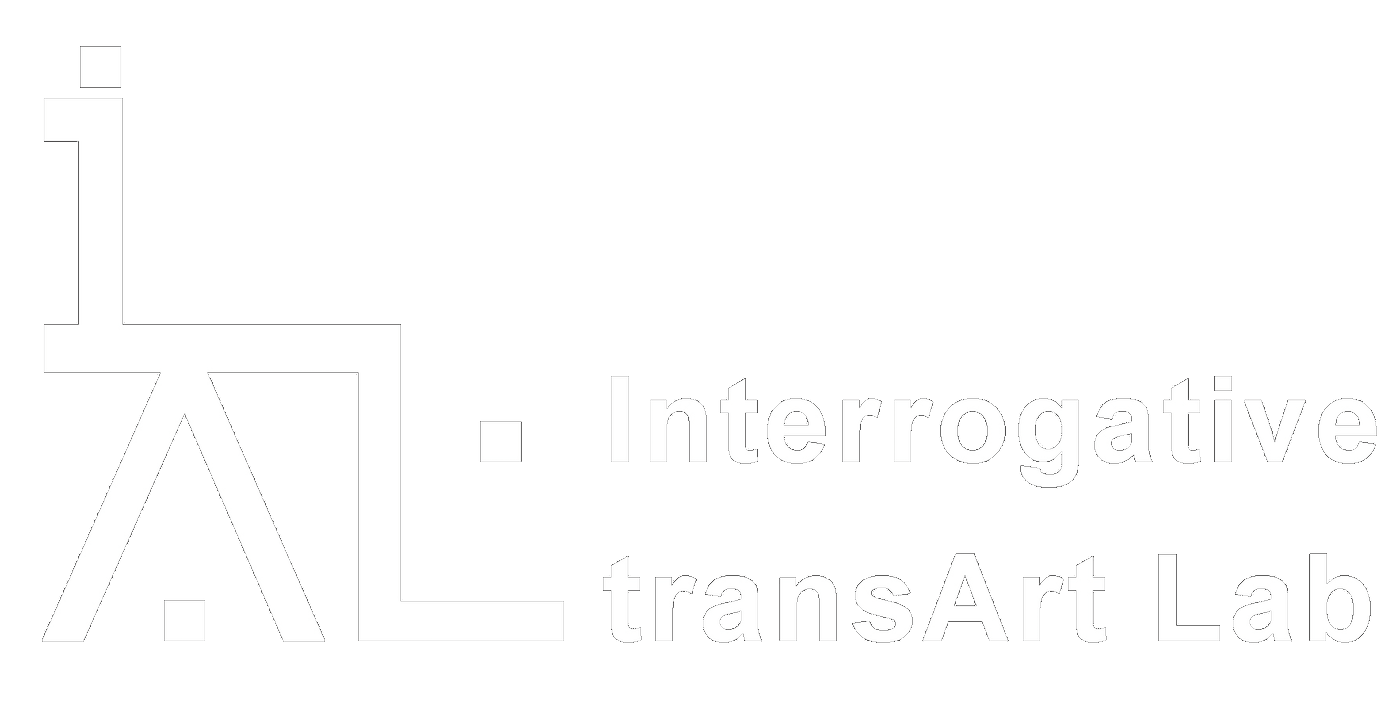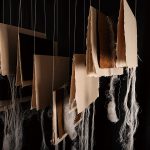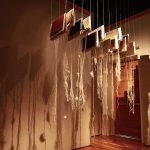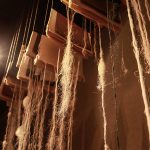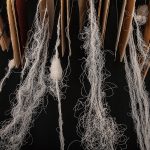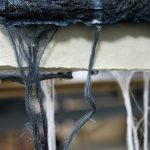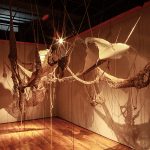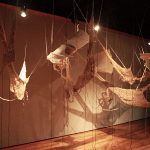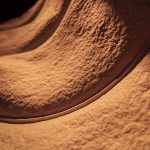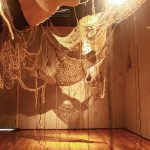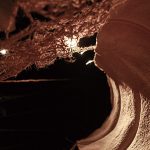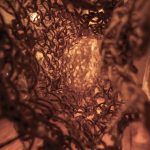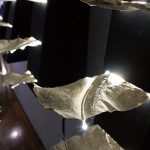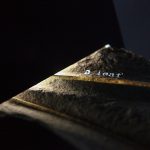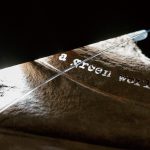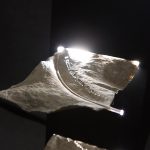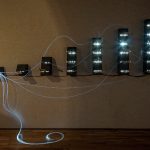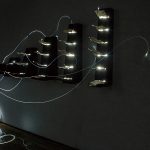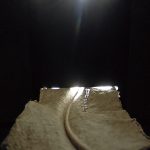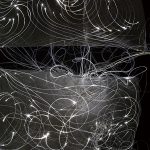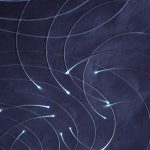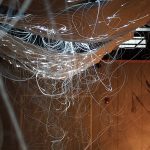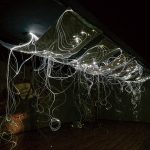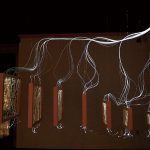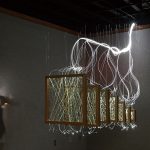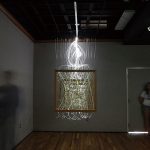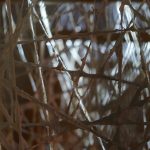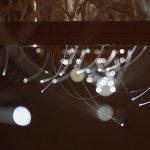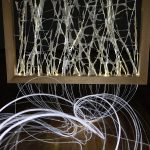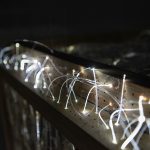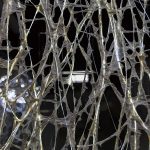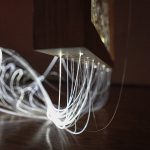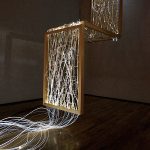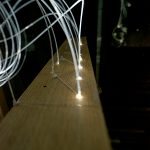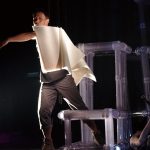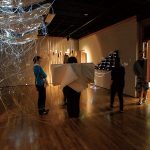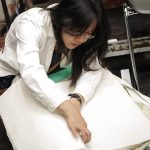《穿越皺褶》 賴雯淑裝置藝術個展
Throughthe Wrinkles— An installation by Wen-Shu Lai 09/12-10/20, 2012
Mariani Gallery, Guggenheim Hall, University of Northern Colorado, Colorado, USA
Reception: Wednesday, September 12, 4-6 pm
” Through the Wrinkles I imagine;
through the wrinkles the artistic spirit is lit.”
The illuminant fiber optic papers are a vehicle for artistic expression and creative evolution. Fiber optic papers are used not only as a light source, but also as an art medium and a metaphor.
─Wen-Shu Lai







作品介紹
創作論述
《穿過皺褶》這個光纖藝術裝置個展的創作靈感來自很多方面,其中一個是起於2011年三、四月間,一次在湖邊散步的偶遇。在朋友的引導下,我在湖邊低地看到一種近乎乾枯的植物(圖一),莖部細長挺直,葉子細尖如野草般,高度約介於腰間至胸前高處,令人詫異的是每一株直立的莖部,都有一個突兀的腫脹處,狀如球體,大小如乒乓球,仔細近看還有一個小小的洞口。根據專攻植物學的朋友說,這種植物長到一個時期時,會有一種生物侵入而引發病變,造成莖部腫脹如球,而這個進駐的生物則在裡面獲得滋養而逐漸成長,最後會突破這個球體離去1。當我再進一步追問植物的名稱,寄生的生物又是什麼時,就都沒有確切答案了。

這個謎樣的植物和那不曾打過照面的進駐者,就這樣進入了我的腦海。我常常看著從湖邊帶回來的不知名植物,想著那個曾經住在裡面的生物,覺得其中有一段不為我所理解,但卻相當重要的「相互關係」曾經存在過。不久,一個隱約的想法慢慢地在心中萌發。很單純地,我開始想要理解這個逐漸與我發生關聯的腫脹狀態,想把這個無法以言語或文字表達的關係再一次地以自己的方式給出。很自然地,我想到蛹進入蛻變的方式,想到它一吸一吐,毫不遲疑地把自己織入一種近乎沒有雜質、寂靜純粹的存在狀態—繭。
為了回應這個想法,我當時試著把大片布料的纖維先一根根地抽離,想像自己的指間吐出絲來,再用手指緩緩地纏繞這些纖維,將他們纏成一個繭狀般的腫脹體 (圖二),有的是中空的,有的則包含著光纖。把由機器織好的布,經緯一條條地分離,再重新把散亂的纖維纏繞成一個繭的過程有點像是,但又不完全是,把「吐絲—作繭—織布」的動作先倒轉之後再正轉,也可說是先逆向拆解,再正向建構。因為抽絲作繭的過程實在很緩慢,慢到幾乎可以感覺到自己的呼吸和手指抽取纖維的聲音被擴大,所以也有點像是進入蠶在吐絲做繭的狀態,也可以說是透過作繭的過程而產生一個逐漸飽滿、重獲力量的對話關係。所以一開始將這個事件稱為「反向作繭‧腫脹計劃」,在接近兩個月的作繭自縛、逐漸腫脹的過程中,我似乎把自己包覆起來,回到一個最原初的狀態,由此蛻變、重生。而後來的作品 “Tenderness/Reverse cocooning” 就是由此繼續演化而來的。在造紙的過程中埋入紗布,有一部分外露垂掛而下,乾燥後再逐一將紗布的纖維剝離,纏繞成類似蠶繭或蟲癭的樣子。手作紙對摺成書頁,逐一垂掛,變成蘊釀生命轉化之所,其中充滿神秘的想像空間。

就生物學的觀點來看,繭是昆蟲進行生命轉化的地方,是蛹化成蝶的必經旅程。日本作家村上春樹 (Haruki Murakami)所寫的小說 《1Q84》 中也有好幾段描寫七個小人兒 (little people) 從空氣中抓取絲,合力編織「空氣蛹」 (air chrysalis) 的故事情節。空氣蛹如蠶絲般,會隱隱散發出光芒,是孕育Mother的分身—Daughter的所在,也像是一個進出世界的通道,更是一個無法以理性、邏輯思考來理解的神祕所在。在卡羅斯‧卡斯塔尼達(Carlos Castañeda)所撰寫的關於巫師唐望的一系列書籍中,也多次提到一個人的眼睛若具備真正「看」的能力,就會察覺到人其實是一個像絲繭般的發光體。不論這些是狂野的想像,還是另一個實相的面貌,我想其中的訊息都是接近猶太哲學家馬丁‧布伯(Martin Buber) 的「對話哲學」中所謂的「真誠相遇」(encounter)、「我-你關係」(I-Thou relation),簡單地說就是不帶虛妄的素面相見,以「完全的我」來與「完全的你」相遇,也是當下本真的相會。而藝術家與其所創造的作品也是如此的真誠關係,必得傾全部的生命來呈現敞亮作品。
從空氣中取絲編織的概念,慢慢地發展出 “AnUnknown Entanglement” 這件裝置作品,不論是手作光纖紙還是亞麻繩編織,都是採取最天然素樸的方式進行創作,例如亞麻繩是用手指直接拉出網袋狀,再做點、線、面的連結和垂掛,就像手指在空中取繩作畫和講故事。土色的大型手作光纖紙,傲然曲張的表面,猶如主人早已不知去向,只剩空屋般的硬殼被遺留下來。雖然如此,無以名狀的糾結牽連卻隱約存在,處處可察。帶狀的通道,是穿梭在知覺與想像之間的方便門。
交換結束,我直接從美國飛墨西哥,參加在首都墨西哥市舉行的「後態度‧台灣年輕當代藝術家聯展‧混種、異地、島嶼的世代」(Post-Actitud El Artecontemporáneo de Jóvenes Artistas de Taiwan El Generación Mixto de la Isla Extraño),在那裡我認識了提早到達的台美藝術家葉偉立,他在美術館Ex Teresa Arte Actual 的花園裡進行就地裝置藝術作品的製作,他用手搓揉一個個的水泥球(圖3左)。我雖然比他早抵達墨西哥,但我的作品還沒運達,所以我每天去花園裡幫忙搓幾個水泥球,聊一下天,然後就會離開,獨自去探索墨西哥。葉偉立告訴我他搓的水泥球,原來是要送給魯佛 (Juan Rulfo)所寫的小說《佩德羅‧巴拉莫》(Pedro Páramo) 中的科馬拉小鎮的鎮民。科馬拉鎮的所有鎮民的名字都一樣,都叫佩德羅‧巴拉莫,是小說中男主角正在尋找的父親的名字,但男主角後來發覺這是一個鬼鎮,所有的人都已死亡,而與他自小分離的父親也早就死去。這個故事當然跟葉偉立的個人故事相關,我也聽得很入迷。我依舊每天到花園搓幾個不成形的水泥球,也沒等它稍乾和修整形狀,就獨自出去探險。後來有人問葉偉立說:”Why don’t you go out and explore Mexico City.” 他回答:”A garden is enough for me. I don’t need the whole city.”。「一座花園對我來講就足夠了,我不需要整個城市。」這句話似乎告訴了我一些事情;而葉偉立對我獨自跑到在Michoacan的火山Paricutin2造訪被岩漿掩埋的教堂遺跡感到很不解。我也只能跟他說,我為我所相信的而活。最後,《後態度》聯展作品在原是古修道院的(前泰瑞莎當代藝術中心)展出時,葉偉立的作品《科馬拉的水泥球》中一部分的水泥球和我的《內在長河》(圖3右)棉線作品一起在大型裝置區呈現。《內在長河》意圖探討的是「回歸」的問題,河流行經之地再遠,終究會回歸大海,但人對其內在長河的體會和其引發的意義卻因人而異。葉偉立的裝置作品是先在台灣製作好100顆水泥球,運至墨西哥現場。然後,於古修道院中,以墨西哥作家Juan Rulfo的小說《Pedro Páramo》和自身的傳記故事為文本,於墨西哥市當地尋找相同的材料製作更多的水泥球,最後台墨兩地的水泥球一起展出,試圖探問身分、轉移與認同之間的關聯。我和葉偉立都是長年旅居美國的台灣人,兩人的身分認同和各自與父親的關係在墨西哥市的花園中相遇,展開了一次真誠卻無太多言語涉入的對話。

葉偉立的「一座花園就足夠了」的話,讓我想起了 Walt Whitman 的詩:I believe a leaf of grass is no less than the journey work of the stars,意指小草的一片葉子跟宇宙星球的旅程相比不減絲毫。後來我又讀到蘇格蘭的博學家 Patrick Geddes 在其所任教的 Dundee 大學的告別演講詞,他提出學習應該根植於生活中,而最棒的原創思考本身就是一個創造的過程。3 在退休演講中他感慨地說,花園成長需要很多年,理想也需要時間來實現,更何況它比玉米的成熟有更多的不確定性,人們都太急於看到成效,急切之情近似選舉要立即看到開票的結果,投資金錢要有立即的回報。我非常同意 Geddes 的觀點,學習是發生在各種的生命經驗中,且需要允許播下的想法有足夠的時間來發芽和成長。也因此,Geddes 的核心思想 “By leaves we live, by living we learn, by creating we think” 就成了 “By leaves we live” 這件作品所要傳達的訊息。
“Through the Wrinkles I Imagine”作品名稱是間接來自 Madeleine L’Engle 寫的小說 “A Wrinkle In Time”(1973)。書中讓我更感興趣的是超立方體(Tesseract)的概念,時間空間的變形可以讓人穿過皺摺到另一個時空,從一個點到另一個點的最近距離若不是直線,那會是什麼?我對時空的皺褶感到好奇,所以就將作品取為 “Through the Wrinkles I Imagine”,透過皺摺我想像宇宙可能是什麼:是放眼望去的星象;是層層皺褶之間散發出的光亮;是無始終的時間;是上下振動的翅膀;前翻後推的書頁之間;還是孕育生命轉化的繭和蟲癭?… “Through the Wrinkles I Imagine”是大型光纖紙所作出的裝置,橫跨展場。觀眾可以看到紙纖維交織著發亮的光纖,形成紋路有致的錯落光面,還有一部分的光纖是垂直穿過光纖紙,捲曲下墜,自成天地。有些觀眾就靜靜地躺在地板上仰望這片宇宙的圖形,久久不去。
作品 “Between the Wrinkles” 是沿著對皺褶的想像,繼續描繪穿過層層皺褶,浸潤在其間的光亮。透過由近到遠,由小到大的光纖光柵,觀者的視域得以穿透前進,也可以隨著纖細的光束流動,進入彼端。
大部分的人對時間最常以過去、現在、未來的觀念來理解,不管是聖奧古斯丁、海德格、愛因斯坦、伯格森、還是巴舍拉,對時間都有過深刻的討論。而我是從皺褶出發,想像時間既不是水平式的前進,也不是垂直性的進入,而是皺摺般地重疊著,就好像我曾經作夢,夢見直接從 Iowa City 到達新竹交大就只是穿過皺摺的瞬間而已。皺摺是柔軟的絲綢,或展開或摺疊,樣態萬千。作品 “The Threefold of Time” 摺疊時是三層方框,展開時,光流就如瀑布般流洩而下。
Ben Shahn 在 “The Biography of a Painting” 一文中寫道:”Follow the imagery backward at least to the point at which they disappear into the limbo of the subconscious, or the unconscious, or the instinctive, or the merely biological.”4。我在2004年的作品 “Limbo”中,把父親軍服上帶有翅膀和螺旋槳意象的肩章放在自己的肩膀上成為雙翅;在2011年做的 “Book of Wings”再次詮釋來自父親的這對翅膀。展翅可以高飛,歇息時雙翅收合,這跟書籍的開合有異曲同工之妙。一開始,這本書是為了讓謝啟民老師在交大跨領域藝術團隊的舞台作品 “回─無盡的迷宮” 作舞蹈表演時所穿戴而特別創作的。表演的最後一幕是在人類文明的廢墟中伏倒,讓書頁遮蓋回到繭的狀態,也是生命再度轉化的開始。Book of Wings這本手作書雖與我有私人的關聯,但人類不也共同擁有一條臍帶,與孕育我們的大地、宇宙相聯嗎?荒原有可能蔓生,成為我們的最終之旅,但高度的覺醒也可以是我們的另一選項。
- 註1: 筆者後來理解所看到的腫脹植物應該就是由昆蟲所引起的癭,可以產生蟲癭的昆蟲,稱做造癭昆蟲(gall-inducing insect)。產生蟲癭的植物,叫做產癭植物。蟲癭通常是由幼蟲或是成蟲食用植物的部位,並注入化學物質、或是母蟲產卵所造成的機械性刺激所引起。以上文字參考自:http://zh.wikipedia.org/wiki/%E7%99%AD,瀏覽日期 3/9/2014。
- 註2: 這座位於San Juan Parangaricutiro 的教堂是於1943年在Paricutin火山爆發時被掩埋的,山下的兩個村落皆被掩埋在火山岩漿下,只有這座教堂的鐘塔幸存下來成為遺址。
- 註3: Patrick Geddes說:”…learning should be rooted in real life experience and that the best original thinking is a creative process”。原文是參考網頁http://ecodesignproject4th.blogspot.tw/2011/11/patrick-geddes-by-living-we-learn-by.html
- 註4: 引用自Ben Shahn 所寫的The Shape of Content. Harvard University Press,1992, p.33。
Artist
Statement
In 2011, I had the opportunity to experiment with papermaking and fiber optics at the Paper Making Research Center at the University of Iowa. Those experiments became the foundation and inspiration for this series of installations at UNC. In January 2012, I sent my installation proposal, “Through the Wrinkles” to UNC Galleries and it was approved. The purpose of this proposed installation is to use the fiber-optic paper I made in 2011 as an art medium to explore various ways of incorporating this medium of light into installations. Fiber-optic paper is used not only as a light source but also as an art medium and a metaphor to enhance the following concept: “Through the wrinkles of light, the artistic spirit is lit.” Illuminant fiber optic paper thus serves as a vehicle for artistic expression and creative evolution.
In 2011, when I was a visiting scholar at the University of Iowa in Iowa City, I made a “Reverse Cocooning Project.” The idea of this project originated from an unexpected encounter during a lakeside walk in Lake McBride State Park.1 Along with my friend from the faculty of Biology, I saw a very thin, weed-like plant that was somewhere between my chest and waist in height. The most stunning thing about the plant was that it had a swollen sphere the size of a table-tennis ball in the middle of its stem(Figure 1).

When I looked closely, I spotted a very small opening on the surface of the swollen area. My friend informed me that an unknown parasitic organism invades and lives inside the plant, inducing the swollen state of a part of the stem. Eventually, the parasitic organism makes a hole and exits the swollen ball when it is fully-grown. On enquiring, I was unable to find further information regarding the names of the plant and the organism. I did not know why but this encounter made me contemplate a lot. Back at my studio in the University of Iowa, I began to often look at this plant I brought back from the lakeside, pondering upon the swelling and the unknown living thing that was once inside. I began to think that there must be an important relationship between the plant and the organism more profound than the obvious parasitic relationship, though I could not fully grasp it then. A vague idea slowly began to emerge in my mind that led me to want to understand what actually caused the swelling. I also felt compelled to bring this swelling into being in a way that could not be described through languages or words. Naturally, this made me think of cocoons. Chrysalises spin and shut themselves inside their cocoons—it is their state of being in the world— nothing but a wholeness and silence.
In response to that, I separated fibers from a piece of fabric and used the tangled fibers to form cocoon-like objects. Some were hollow; some were not. First, I separated cloth into fibers and then I weaved the fibers into a cocoon-like object (Figure 3), this process resembled reverse cocooning. It was a deliberately destructive act that was done before the construction could take place. It was also a very slow and quiet process—I could clearly hear my own breath. The slowness of the progress even amplified the noise from the separation of the cloth fibers. I felt I was a chrysalis, gaining strength by listening to my own inner voice and weaving myself into a cocoon prior to my rebirth.

The first installation piece that I created, “Tenderness/Reverse cocooning,” emerged from my “Reverse Cocooning Project.” Several pieces of fabric were imbedded to form the paper. After the pieces of paper dried, the fibers grew out of the paper by separating the fabric into fibers. The installation is a book with loose pages hanging directly from the ceiling, and each page is the home of a cocoon or a potential home for a cocoon-to-be.
From a biological perspective, a cocoon is a place where a transformation of life occurs. For a caterpillar, it is a necessary journey to turn into a butterfly. The novel 1Q84 by Haruki Murakami has vivid descriptions of seven little people who built a cocoon-like Air Chrysalis by grasping silk in the air. Inside the illuminant silk-like Air Chrysalis, the daughter—the double of the Mother—was born. It also seemed to be a portal that connected two worlds (or a parallel universe)—a mysterious place that one cannot understand through logical thinking or reasoning. This mysterious place is created for us to think and to imagine.
Carlos Castañeda (1925-1988) writes in his writing that a human also resembles an illuminant cocoon if one’s eyes can truly “see.” Even if these things are products of a wild imagination or facts about an alternative reality, I think that the hidden message is about genuine encounters with people, things, and the world. In Martin Buber’s words, the genuine encounter is an I-Thou relation, the most beautiful relationship that a human being could have with people, nature, and God. To an artist, the encounter with his/her artwork is one of them. It is the presence of the artist and the artwork. In my experience, a mutual and supportive relationship was built between me and the material I worked with by realizing this exhibition, resembling the unique bond described by Buber.
My imagined version of the Air Chrysalis and illuminant cocoon is the origin of the piece “An Unknown Entanglement.” To me, art making is about living, thinking, and imagining. I used natural material hemp to make tunnels by using the simple techniques of knitting. Through this project, I hope to gain a better understanding of the potential of these materials and my use of them. Transforming everyday materials into a new art form through praxis is the purpose of this project. My presence and the materials’ presence is a close encounter that is actualized through the acts of art making and critical reflection. It is a transformation not only from materials to forms, but also from the physical world to the spiritual world. Thus, a life is reborn, and its meanings are reconfirmed and reconstructed.
My imagined version of the Air Chrysalis and illuminant cocoon is the origin of the piece “An Unknown Entanglement.” To me, art making is about living, thinking, and imagining. I used natural material hemp to make tunnels by using the simple techniques of knitting. Through this project, I hope to gain a better understanding of the potential of these materials and my use of them. Transforming everyday materials into a new art form through praxis is the purpose of this project. My presence and the materials’ presence is a close encounter that is actualized through the acts of art making and critical reflection. It is a transformation not only from materials to forms, but also from the physical world to the spiritual world. Thus, a life is reborn, and its meanings are reconfirmed and reconstructed.
After my exchange term was completed, I flew to Mexico to join the group exhibition of Taiwanese young artists in Mexico City.2 There I met American Taiwanese artist Wei-li Yeh, who arrived at Ex Teresa Arte Actualto Museum to prepare his installation in the garden(Figure 3 left). He made concrete balls with his hands. In the morning, I stopped by the garden to help him make a couple of balls before I left to go on an adventure. One day he told me that the balls he made in the garden are also gifts for the villagers in Comala, a ghost town in Juan Rulfo’s novel Pedro Páramo.3 The story is somehow connected to Yeh’s personal story, and I was very drawn to it. I felt that I connected with Yeh because he had told me that story. Later, someone asked Yeh why he does not go out to explore the City. He replied that a garden is enough for him; he does not need the whole city. What he said answered some of my questions, though he did not know it. Before leaving Mexico City, I visited the ruins of San Juan Parangaricutiro Church, which was buried after the Parícutin volcano erupted in 1943. Yeh could not understand why I travelled far and alone to see the ruins. The only answer I could think of is “I live by what I believe.”

Yeh’s garden reminds me of Walt Whitman’s poem “I believe a leaf of grass is no less than the journey work of the stars.”4 It then follows that in a garden we see the world, even the universe. Later, I read Patrick Geddes’s farewell lecture to his students at Dundee University, where he said the following:
How many people think twice about a leaf? Yet the leaf is the chief product and phenomenon of Life: this is a green world, with animals comparatively few and small, and all dependent upon the leaves. By leaves we live.
But growth seems slow, and people are all out for immediate results, like immediate votes or immediate money. A garden takes years and years to grow – ideas also take time to grow, and while a sower knows when his corn will ripen, the sowing of ideas is, as yet, a far less certain affair.
I cannot agree more with what Geddes has said regarding how learning takes place in various situations in life, and ideas take time to grow. Inspired by Geddes’s words, I created the installation “By Leaves We Live” to deliver Geddes’s message: “By leaves we live, by creating we think, by living we learn. Teach with love and logic—heart, head, and hand.”5 What Geddes said touched me profoundly. To express my ultimate respect to this great educator in our generation, this installation is dedicated to him and those people who hold similar beliefs. In this installation, I use six wooden boxes to house 21 leaves made from handmade paper imbedded with fiber optics. Each leaf has laser cut words on the surface that are phrases from Geddes’s farewell lecture.
The installation “Through the Wrinkles I Imagine” was inspired by Madeleine L’Engle’s novel A Wrinkle In Time.6 The story revolves around a fourteen-year-old girl Meg Murry whose father goes missing after working on a mysterious project called tesseract. What fascinates me most in the novel is the concept of tesseract. Tesseract is a term that describes the “wrinkling” of time and space. It is more or less like a portal from one area of space to another.7 If a straight line is not the shortest distance between two points, then what it is? Can we travel through space by penetrating the wrinkles? I cannot help imagining what the universe would look like through the wrinkles. Are they the constellation in our eyes, the luminescence among the wrinkles, the endless time, the vibrating wings, the turning of pages, or the insect gall and cocoon for life transformation? The work “Through the Wrinkles I Imagine” is a large-scale installation. Six 220cm by 120cm sized handmade fiber-optic pieces of paper are hung across the ceiling. The audience members not only see the luminescent pattern of fiber optics, but they also see the curling light in the space, which is a universe by itself. Some of the audience have even laid down on the floor and fallen into a total silence.
Following my imagination, the “Between the Wrinkles” installation is intended to describe the light between the wrinkles. From close to far away, from small to large, the view of the audience penetrates the wrinkles and floats into the river of fiber optics, where the light leads to the other side.
Most people understand time as the past, the present, and the future. St. Augustine, Heidegger, Albert Einstein, Bergson, and Bachelard have all discussed time extensively. In my own work, I choose to concentrate on neither the horizontal nor the vertical aspects of time but the wrinkles in time in order to understand temporality. I once dreamed of returning to Hsinchu from Iowa City in a blink. Wrinkles are soft silks that can be unfolded or folded; their looks are multifold. The installation “The Threefold of Time” is derived from this concept. It is a three-layer wood piece when folded and streams of light fall coming from above fall through it when unfolded.
In “The Biography of a Painting,” Ben Shahn writes, “Follow the imagery backward at least to the point at which they disappear into the limbo of the subconscious, or the unconscious, or the instinctive, or the merely biological.”8 In my early work “Limbo” (2004), I transformed my father’s uniform pin into my wings.9 In 2011, I created “Book of Wings”(Figure 13) to reinterpret the wings from my father. Wings can fly high when unfolded and are folded again when at rest. Wings and books are alike in terms of folding and unfolding. To me, a book is an important vehicle for passing on cultural and spiritual heritage, and bookmaking is a “soul making” journey. It often takes years to complete a book.
The “Book of Wings” was originally designed and made for my colleague, Professor Chi-Min Shieh, who is a dancer. When Shieh wore the book while dancing in a stage piece titled “Hui,” meaning “reincarnation” and “eternal return,” the pages of the book looked like a pair of wings as they flapped open and shut with his movements while he was searching among the debris. It is an act that expresses the sublimation of the human spirit and hope for freedom. In the last scene, Hsieh is covered by the pages of the book and remained motionless, like a cocoon on the floor, undergoing a state of life transformation. Personally, the “Book of Wings” connected with my ownprivate memories. However, the book also connected with the earth, the universe, and others through an umbilical cord that we all share. In other words, we are all on the same boat. The vast ocean and endless journey can be our destiny but awareness and a safe harbor can be our alternatives.
- Lake Macbride State Park lies in the state of Iowa, county of Johnson.
- The title of the 2011 group exhibition is “Post-Actitud El Artecontemporáneo de Jóvenes Artistas de Taiwan El Generación Mixto de la Isla Extraño.”
- The novel portrays a man’s quest for his Mexican heritage. The story begins with the first person account of Juan Preciado, who promises his mother at her deathbed that he will return to Comala to meet his father, Pedro Páramo. Juan encounters one person after another in Comala, each of whom he perceives to be dead. Midway through the novel, Preciado dies.
- This citation is from Walt Whitman’s “Song of Myself” Part 2 (1819-1892): 31 “I believe a leaf of grass is no less than the journey work of the stars, /And the pismire is equally perfect, and a grain of sand, and the egg of the wren, /And the tree-toad is a chef-d’oeuvre for the highest, /And the running blackberry would adorn the parlors of heaven, /And the narrowest hinge in my hand puts to scorn all machinery, /And the cow crunching with depress’d head surpasses any statue, /And a mouse is miracle enough to stagger sextillions of infidels.”
- Text cited from http://ecodesignproject4th.blogspot.tw/2011/11/patrick-geddes-by-living-we-learn-by.html (accessed on 03/27/2014)
- A Wrinkle in Time by Madeleine L’Engle, Published by Square Fish; Reprint edition, 2007.
- If one take points A and B and connect them with a piece of string, the shortest route would be to walk along the straight piece of string. But through tesseract, one could wrinkle the string, or fold it upon itself, so that points A and B would be right next to each other, allowing people to just walk across. It is how the people travel to distant planets in the novel A Wrinkle in Time.
- The Shape of Content is a book collects six lectures delivered by Ben Shahn,. Harvard University Press,1992, p.33
- The pin looks like a bird as well as an airplane. The image is an integration of an eagle’s wings and a propeller, a symbol of my father’s strength.
